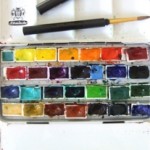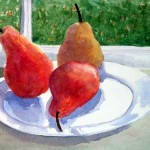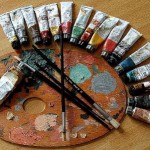Artist : Watercolor vs. Oil Painting Techniques
If you’ve been oil painting…
you’ve been working in a medium in which you are continually able to add layers of pigment to achieve desired results, and if it doesn’t appear exactly the way you expected; you can completely cover over it… or if the area you’re not happy with is still wet; you can even wipe off anything you don’t ‘like.
The opposite is true when you work with watercolors…
Watercolor painting uses different techniques of applying paint, & it requires that you have to learn to think ‘subtractively’, a complete departure from what you are used to doing when you are using oil painting techniques, (where using ‘under-painting’ as well as relying on previous layers; are elements that are used to create depth).
Artist Painting Techniques : Highlights
The artist painting techniques involved in achieving highlights differ greatly in watercolor painting vs. oil painting. In oil painting, the darkest ‘values’… or hues; are placed 1st, then gradually lighter ones are added; especially when creating shadows & highlights. For instance, when executing the elements that make up a fold in an article of clothing; the artist blends these hues together gradually, while still maintaining the colors and values which create the different parts, making it recognizable as a ‘fold’.
Artist Painting Techniques : Watercolor
In watercolor painting…
the lightest or ‘highlighted’ areas, are achieved by either leaving the watercolor paper ‘blank’ or by applying a material known as ‘masking’, which is brushed on, allowed to dry, and then later removed. This leaves the paper underneath completely untouched by other paints, and ready for you to apply a lighter color; (or if necessary… no color at all). It is in this way, that the lightest highlights in the painting can be accomplished.
Another major difference between artist painting techniques using oils or with using watercolors, is the fact that with watercolors; the artist cannot remove the paint that was applied. This means that careful planning beforehand, is necessary in order to prevent making ‘costly’ mistakes that could have been forseen and used to avoid ruining an otherwise successful painting. Imagine creating your idea of a ‘perfect’ watercolor, and at the very end having one bad element destroy all the effort you’ve put into it.
Artist Painting Techniques : Applying a ‘Wash’
Other noticeable differences in artist painting techniques include; the use of watercolor techniques in which you apply water to the paper before you add paint known as a ‘wash’ , There are different types of washes, including: ‘flat’ and ‘graded’. A ‘flat’ wash is the basic form of this method, where the pigment is added right out of the tube, whereas in ‘graded’ washes, the pigment is diluted before adding it to the previously wet surface.
Artist Painting Techniques : ‘Glazing’
is another technique used in watercolor painting, which is similar to a wash, however; instead of the paper being wet before you apply the glaze… a thin, transparent layer of pigment is applied over previously applied layers; which were allowed to dry completely. It is crucial to resist the temptation to try to re-work an area that is already drying, in order to avoid having a major disaster happen to your painting. With glazing,you can apply as many layers that you feel are necessary; in order to get the effect you are trying to achieve.
Artist : Painting Techniques | Dry-Brushing
Another popular watercolor technique that is used in watercolor painting, is referred to as ‘dry-brushing’. With this method, the paintbrush is loaded with paint that contains & is diluted with very little water. The paper is completely dry when the paint is applied, and the brush strokes create sharp & crisp types of shapes with hard edges.
Artist Painting Techniques : Differences between these two Techniques
Lastly, & probably an obvious difference…
regarding a watercolor vs. oil painting, is most noticeable when comparing drying times. Oil painting affords the artist nearly indefinite amounts of working time, whereas; with watercolor painting, you have much less time in terms of how long you have to work with your pigments.
Artist Painting Techniques : Resources
There are more painting methods than those I have discussed here in this article, and many resources available to anyone interested in really pursuing either of these mediums; such as books, & web-based articles or videos.




